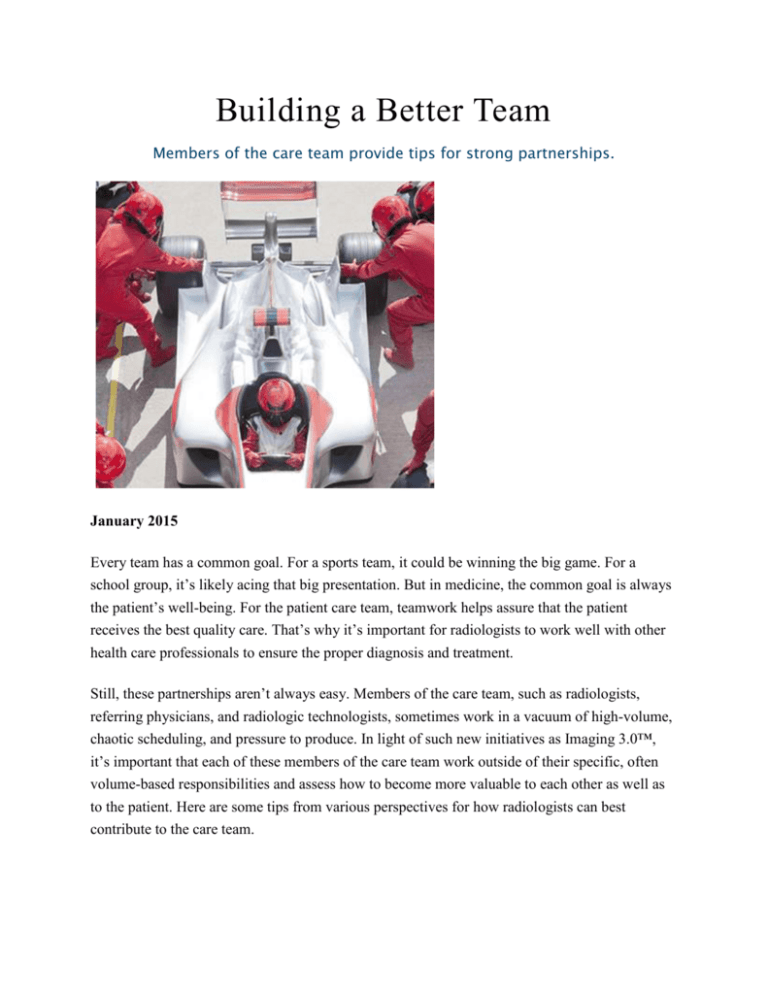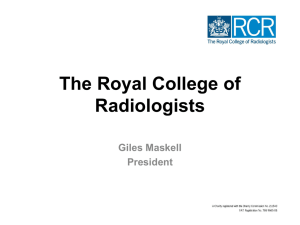
Building a Better Team
Members of the care team provide tips for strong partnerships.
January 2015
Every team has a common goal. For a sports team, it could be winning the big game. For a
school group, it’s likely acing that big presentation. But in medicine, the common goal is always
the patient’s well-being. For the patient care team, teamwork helps assure that the patient
receives the best quality care. That’s why it’s important for radiologists to work well with other
health care professionals to ensure the proper diagnosis and treatment.
Still, these partnerships aren’t always easy. Members of the care team, such as radiologists,
referring physicians, and radiologic technologists, sometimes work in a vacuum of high-volume,
chaotic scheduling, and pressure to produce. In light of such new initiatives as Imaging 3.0™,
it’s important that each of these members of the care team work outside of their specific, often
volume-based responsibilities and assess how to become more valuable to each other as well as
to the patient. Here are some tips from various perspectives for how radiologists can best
contribute to the care team.
Personalize Interactions
According to Beth Weber, MPH, RT(R), RBMS, CRA, radiologic technologist (RT) at Avera
Heart Hospital in South Falls, S.D., interacting face-to-face with other members of the team is
extremely valuable. “It’s important to know a face on the other end of the phone, but a lot of
people don’t put much value in that,” Weber says. “Being in the same room and having that faceto-face conversation humanizes the discussion.”
Rather than remaining isolated in the reading room to maximize reads, Weber encourages
radiologists to meet with their RTs in person. Get to know your technologists, hospital
administration, and other staff members by asking questions and showing genuine interest. Do
they have a family? What school did they attend? Weber also suggests bringing up an interesting
case or asking about a recent patient. “It’s OK to say, ‘How’d that patient ever turn out?’ Be
interested and do some follow-ups” to show your genuine interest in your colleagues and your
shared patients, she says.
Nabile M. Safdar, MD, MPH, vice chair of informatics at Emory University Department of
Radiology and Imaging Sciences in Atlanta, agrees about personalizing interactions. This has
become even more important in a world where technology makes it easy to avoid in-person
communication. “Increasingly, people are reading from remote sites,” he explains. But that
doesn’t mean you can’t make an effort to personalize every interaction with patients and
colleagues — whether it’s simply picking up the phone to follow-up, ensuring you have met your
RTs and clinicians in person, or meeting with a patient directly when he or she has questions.
Weber says that having strong personal relationships with your staff makes it easier for the
patient care team to work together on issues like getting better histories. Clearly, this can be
hugely beneficial to patient outcomes.
For Safdar, face-to-face interaction with other care team members also extends beyond daily
practice. “Sometimes establishing a good relationship means meeting in person, talking on the
phone, or joining a hospital committee,” he adds.
“If you can really understand the specific needs of your referring physicians, you can
tailor your interactions to best suit their needs and your own.” —Sachin H. Jain, MD,
MBA
Encourage Feedback
When working as part of a team, tension is inevitable. Even though personal contact can help
avoid these strains, what should you do when they arise? Weber says one helpful approach is to
be open-minded and receptive to feedback. “Maybe the last conversation you had with an RT
was not a smooth one. Don’t turn your back and say, ‘Well, I’m not going to deal with this
person or situation.’” Instead, Weber suggests making an effort to ensure the next interaction is
more productive.
Weber also suggests encouraging RTs and other staff to come to you with questions and
feedback. Always thank RTs for their work and give them the opportunity to follow up with you.
“An open-door policy makes you more approachable,” she says. And don’t forget to contact RTs
with positive feedback. “Make an extra effort in saying, ‘Hey, those images looked really good,’
or ‘I really appreciated you getting that better history because it helped my diagnosis.’ We live in
a world of negatives, and it’s great to have a positive once in a while.”
Safdar has seen positive results from having an open-door policy with RTs. “If I protocol a study
in a way that isn’t the best, I want RTs to feel comfortable telling me I should consider doing it
differently in the future,” he says, “or saying, ‘I’m concerned that you forgot to specify the T2
sequence.’” Providing critical feedback to colleagues is uncomfortable for many people, but
doing so can greatly improve patient care. Safdar emphasizes that radiologists should be sure to
let RTs know that they expect and value their input. This is an integral first step in creating a
culture in which team members at all levels feel comfortable contributing to smoother operations
and better care for patients.
Sachin H. Jain, MD, MBA, attending hospitalist physician at Boston’s Veteran Administration
Hospital and lecturer in health care policy at Harvard Medical School in Cambridge, Mass., says
radiologists and referring physicians have a similar opportunity to keep educating one another. “I
think building that sort of continuous learning relationship will ultimately enable quality
improvement and a stronger bond going forward,” he explains. Asking questions and providing
feedback can be a two-way street. Jain says that the best interactions he’s had with radiologists
include both physicians seeking to know more about the patient: “That common bond brings us
together in the clinical situation.”
“We need to keep supporting each other, and we need to do it for the patient.” —
Beth Weber, MPH, RT(R), RBMS, CRA
Know Your Role
When it comes to tensions, Safdar believes many problems stem from the confusion of roles. For
radiologists who communicate directly with patients, it’s often difficult to know which
information referring physicians would prefer to deliver themselves. To avoid confusion and
conflict with a referring physician, “I often just arm the patient with the right questions,” Safdar
says. “I tell them, ‘I’m the radiologist. I’m not the person who makes your health care decisions.
That’s between you and Dr. Smith. But if I were you, when I went back to him, I would ask these
questions: Do I need to get surgery or can I continue with a more conservative treatment? Do I
need any other tests?’ That approach respects the patient-physician relationship while
acknowledging that patients increasingly want more information about their imaging results
before meeting with their primary-care or referring physician.”
Jain adds that individual referring clinicians have different preferences, and radiologists should
get to know theirs well enough to decipher what they expect. “Some referring physicians really
like getting phone calls from radiologists, others prefer email, and others prefer talking in
person,” Jain says. “If you can really understand the specific needs of your referring physicians,
you can tailor your interactions to best suit their needs and your own.”
In addition to knowing one’s role, team members need to realize that nearly all health care
professionals are under pressure. “I don’t think radiologists always realize how difficult it is for
other physicians to manage the plethora of results they receive from labs, pathology, and
imaging,” explains Safdar. He adds that because of forces on both sides of the fence, care team
members occasionally resent each others’ questions or comments. “There has to be an
understanding that when people call to ask a question, they’re not doing it to bug you,” he says.
“It’s out of concern for the patient. That should be enough common ground to forgive any
interruptions, misconceptions, or misunderstandings.” Weber agrees: “We need to keep
supporting each other, and we need to do it for the patient.”
By Alyssa Martino, freelance writer for the ACR Bulletin
© 2015 American College of Radiology. All rights reserved.
Content is produced by ACR Press. Opinions expressed in the ACR Bulletin are those of the author(s); they do not
necessarily reflect the viewpoint or position of the editors, reviewers, or publisher. No information contained in
this website should be construed as medical or legal advice or as an endorsement of a particular product or
service.






